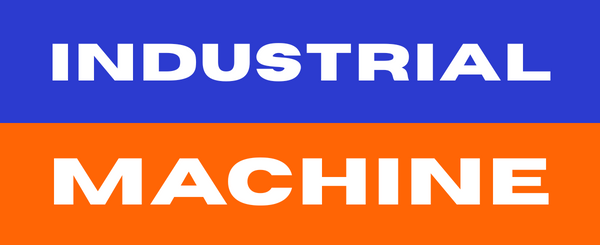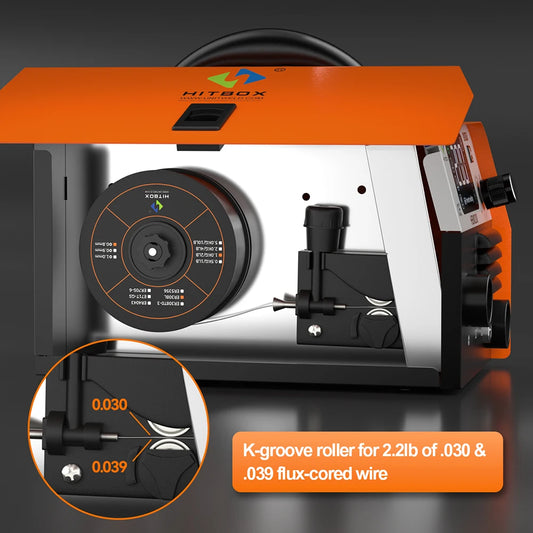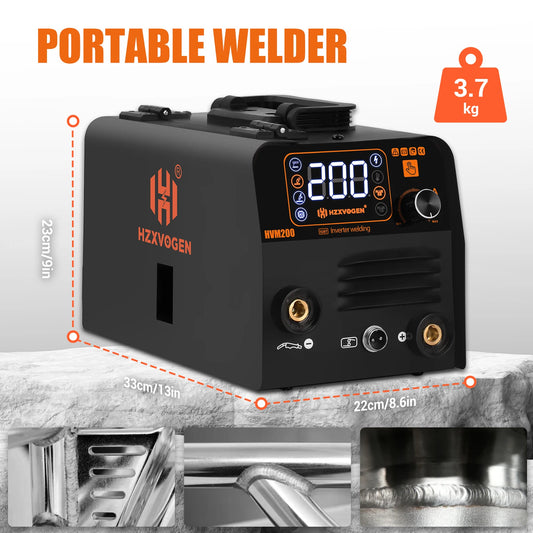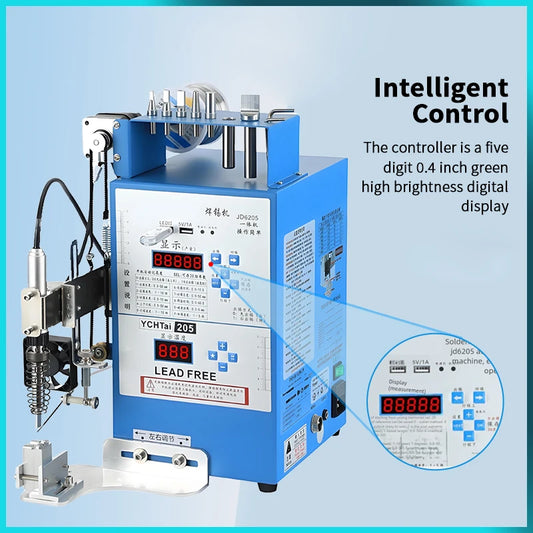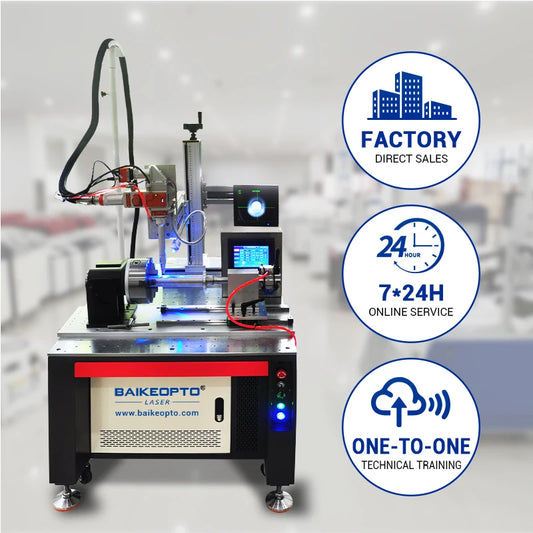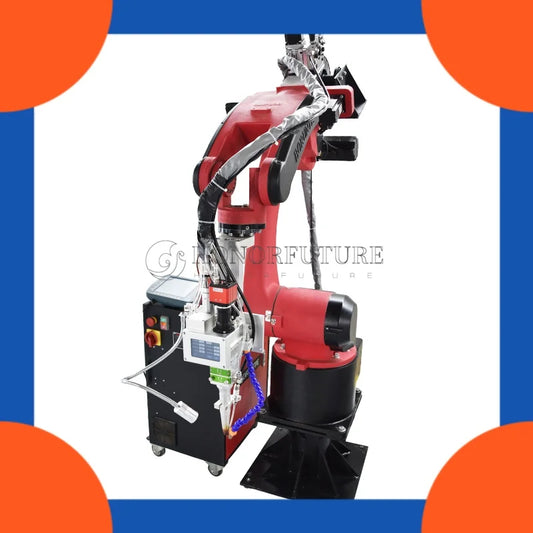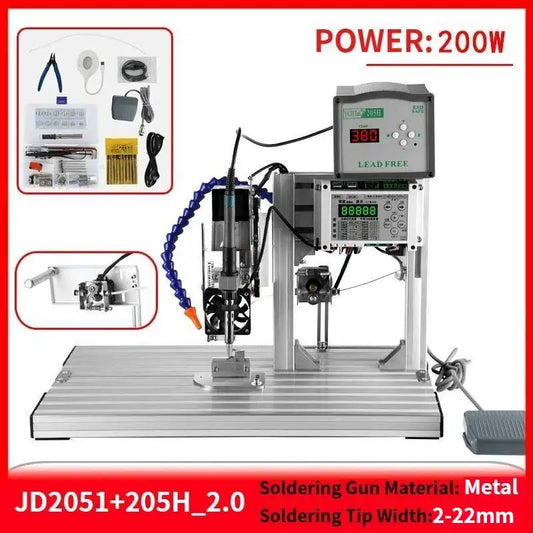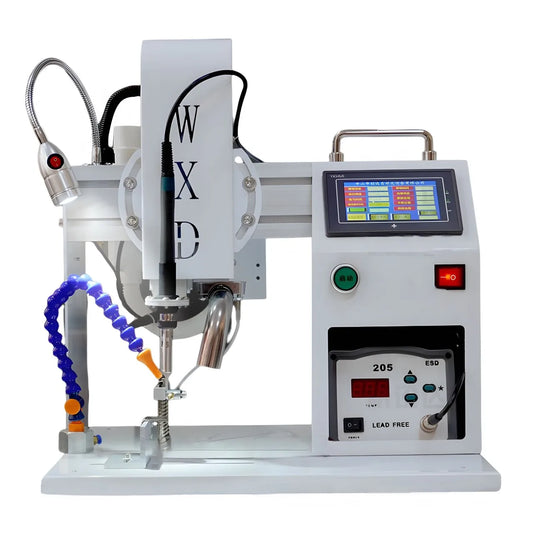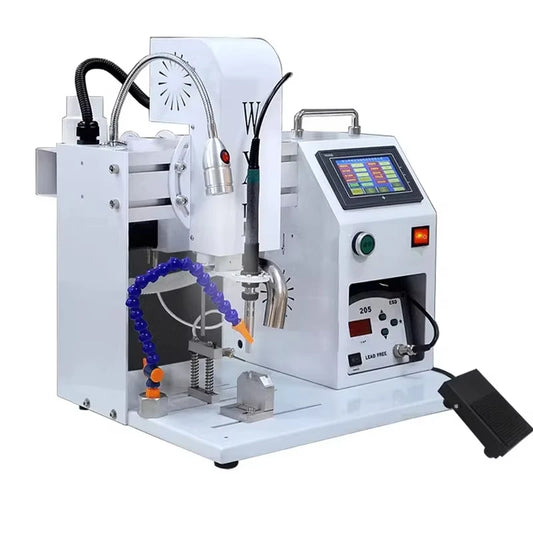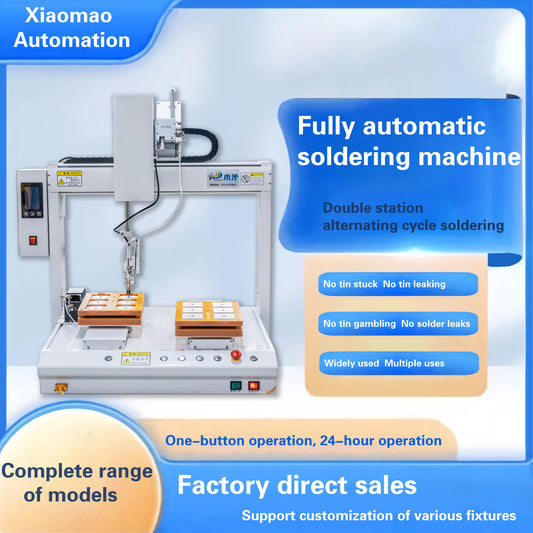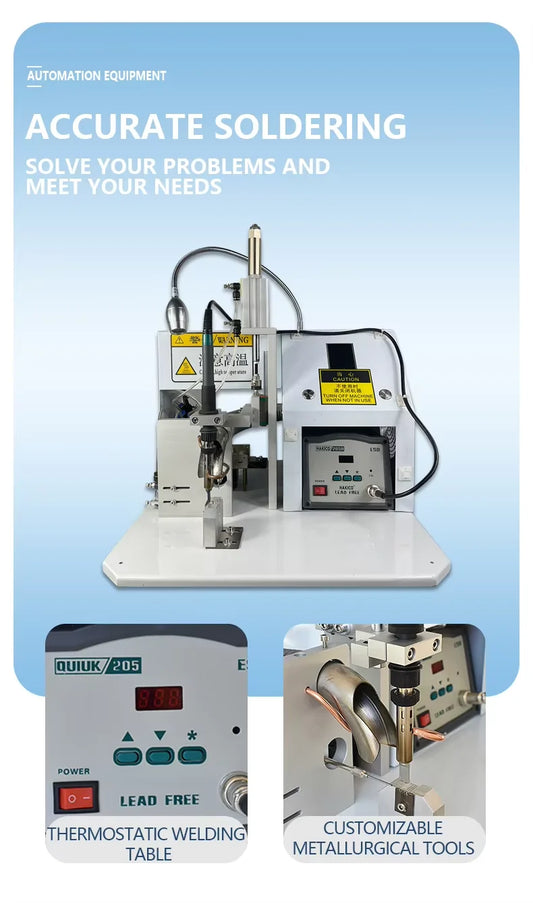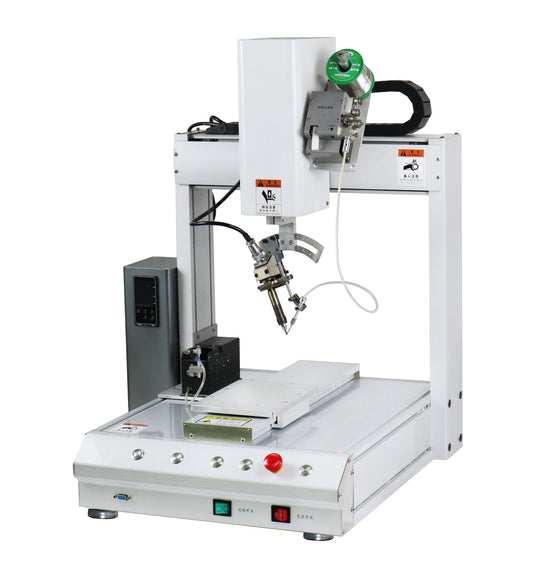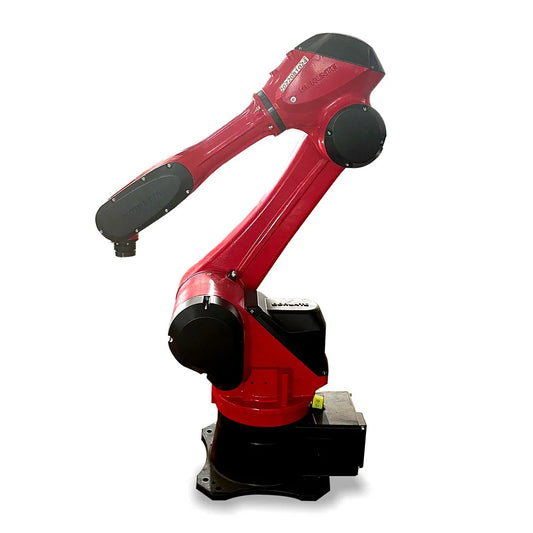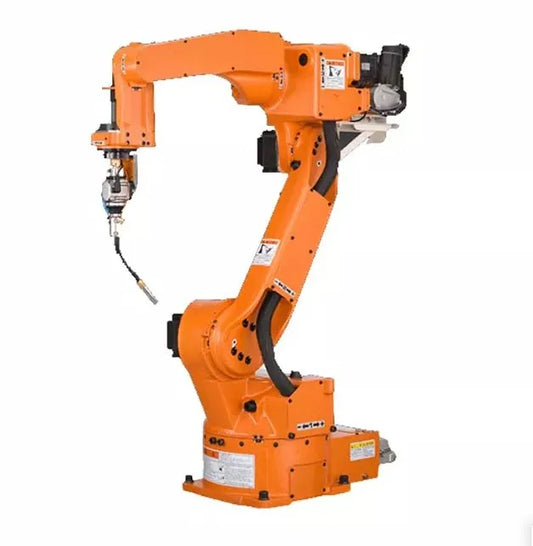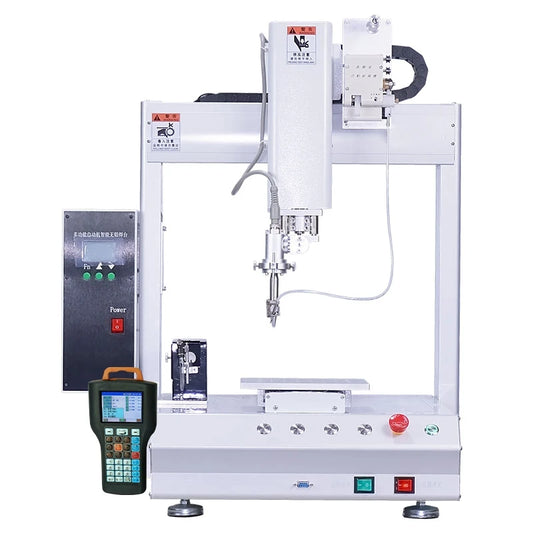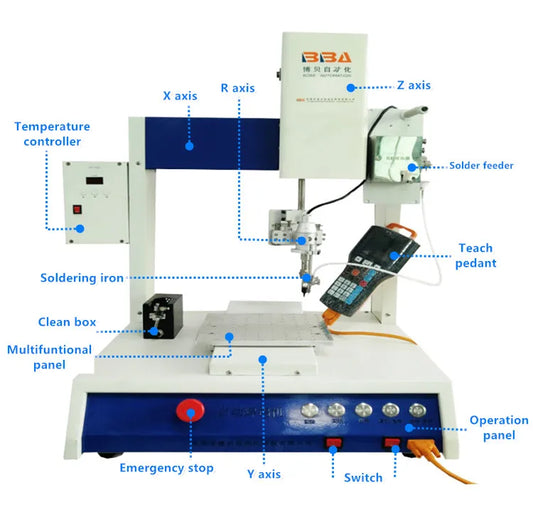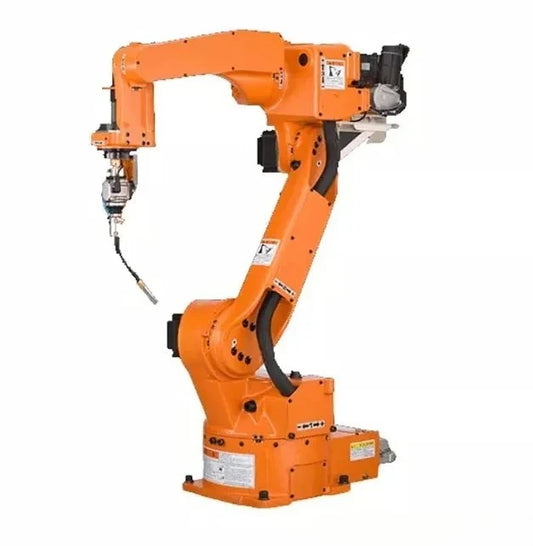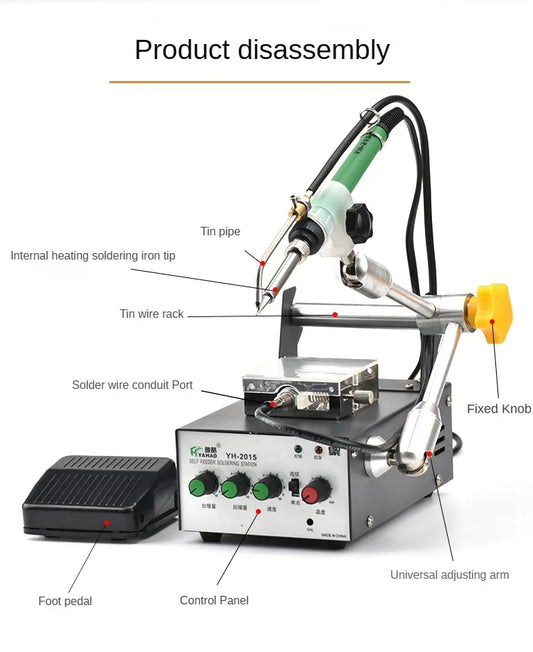Collection: Robotic Welding Systems
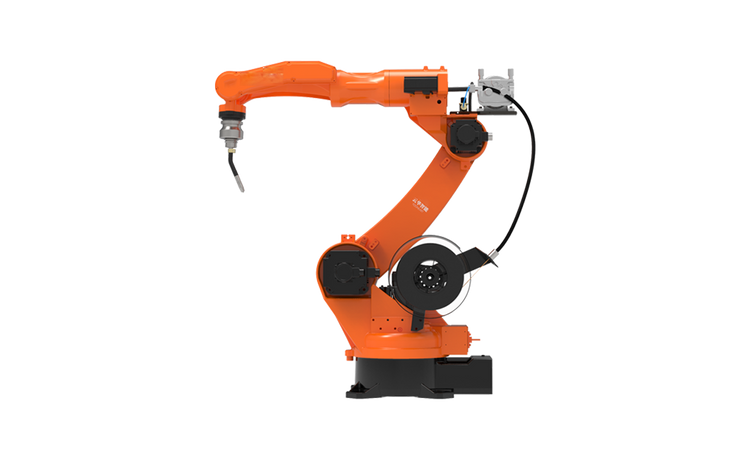
-
HITBOX Non Gas Semi-automatic Welding Machine 3 in 1 MIG/LIFT TIG/MMA Inverter Welder Synergy Tool For Gasless Soldering HBM200
Vendor:Industrial Machine™Regular price From CHF 95.81Regular priceUnit price / perCHF 0.00Sale price From CHF 95.81HITBOX Non Gas Semi-automatic Welding Machine 3 in 1 MIG/LIFT TIG/MMA Inverter Welder Synergy Tool For Gasless Soldering HBM200
Regular price From CHF 95.81Regular priceUnit price / perCHF 0.00Sale price From CHF 95.81HITBOX Non Gas Semi-automatic Welding Machine 3 in 1 MIG/LIFT TIG/MMA Inverter Welder Synergy Tool For Gasless Soldering HBM200
Regular price From CHF 95.81Regular priceUnit price / perCHF 0.00Sale price From CHF 95.81 -
HZXVOGEN 3 in1 MIG/TIG/MMA Semi-Automatic Welding Machine HVM200 Inverter Welder Synergy Tool Non Gas For Gasless Iron Soldering
Vendor:Industrial Machine™Regular price From CHF 109.26Regular priceUnit price / perCHF 0.00Sale price From CHF 109.26HZXVOGEN 3 in1 MIG/TIG/MMA Semi-Automatic Welding Machine HVM200 Inverter Welder Synergy Tool Non Gas For Gasless Iron Soldering
Regular price From CHF 109.26Regular priceUnit price / perCHF 0.00Sale price From CHF 109.26HZXVOGEN 3 in1 MIG/TIG/MMA Semi-Automatic Welding Machine HVM200 Inverter Welder Synergy Tool Non Gas For Gasless Iron Soldering
Regular price From CHF 109.26Regular priceUnit price / perCHF 0.00Sale price From CHF 109.26 -
MultiFunction Semi-Automatic Soldering Machine with Foot Switch Light Belt Motor USB2 Wire Soldering Tool Point Soldering Device
Vendor:Industrial Machine™Regular price From CHF 278.61Regular priceUnit price / perCHF 0.00Sale price From CHF 278.61MultiFunction Semi-Automatic Soldering Machine with Foot Switch Light Belt Motor USB2 Wire Soldering Tool Point Soldering Device
Regular price From CHF 278.61Regular priceUnit price / perCHF 0.00Sale price From CHF 278.61MultiFunction Semi-Automatic Soldering Machine with Foot Switch Light Belt Motor USB2 Wire Soldering Tool Point Soldering Device
Regular price From CHF 278.61Regular priceUnit price / perCHF 0.00Sale price From CHF 278.61 -
Optimize Production with the BK-PH1500P Versatile Welder, Featuring Non-Contact Welding and Minimal Heat Impact
Vendor:Industrial Machine™Regular price From CHF 1,043.62Regular priceUnit price / perCHF 0.00Sale price From CHF 1,043.62Optimize Production with the BK-PH1500P Versatile Welder, Featuring Non-Contact Welding and Minimal Heat Impact
Regular price From CHF 1,043.62Regular priceUnit price / perCHF 0.00Sale price From CHF 1,043.62Optimize Production with the BK-PH1500P Versatile Welder, Featuring Non-Contact Welding and Minimal Heat Impact
Regular price From CHF 1,043.62Regular priceUnit price / perCHF 0.00Sale price From CHF 1,043.62 -
Automatic Robot Arm Welding Machine Six AIXS Robotic Arm Welder Fiber Laser Welding Machine
Vendor:Industrial Machine™Regular price From CHF 3,259.60Regular priceUnit price / perCHF 0.00Sale price From CHF 3,259.60Automatic Robot Arm Welding Machine Six AIXS Robotic Arm Welder Fiber Laser Welding Machine
Regular price From CHF 3,259.60Regular priceUnit price / perCHF 0.00Sale price From CHF 3,259.60Automatic Robot Arm Welding Machine Six AIXS Robotic Arm Welder Fiber Laser Welding Machine
Regular price From CHF 3,259.60Regular priceUnit price / perCHF 0.00Sale price From CHF 3,259.60 -
BBA Semi Automatic USB Cable Soldering Machine PCB Welding Robot Best Iron Soldering Machine For Wire Cables Welding
Vendor:Industrial Machine™Regular price CHF 2,154.66Regular priceUnit price / perCHF 0.00Sale price CHF 2,154.66 -
YX5331-T Pcb Soldering Robot Automatic Tin Feeding Machine Robotic Solder for Circuit Board Welding Iron Soldering Machine
Vendor:Industrial Machine™Regular price CHF 4,426.19Regular priceUnit price / perCHF 0.00Sale price CHF 4,426.19 -
5 Axis Solder Iron Robot Automatic Tin Feeding Machine YX5331-T LED Pcb Soldering Machine for Circuit Board Welding
Vendor:Industrial Machine™Regular price CHF 4,426.19Regular priceUnit price / perCHF 0.00Sale price CHF 4,426.19 -
Automatic 4-Axis Solder Robot, PCB LED Desktop Welding Soldering Machine With Vision Function
Vendor:Industrial Machine™Regular price CHF 34,457.39Regular priceUnit price / perCHF 0.00Sale price CHF 34,457.39 -
YX331-T Pcb Soldering Robot Automatic Tin Feeding Machine Robotic Solder for Circuit Board Welding Iron Soldering Machine
Vendor:Industrial Machine™Regular price CHF 4,067.31Regular priceUnit price / perCHF 0.00Sale price CHF 4,067.31 -
YX5331-T 5 Axis Solder Iron Robot Automatic Tin Feeding Machine LED Pcb Soldering Machine for Circuit Board Welding Iron
Vendor:Industrial Machine™Regular price CHF 4,426.19Regular priceUnit price / perCHF 0.00Sale price CHF 4,426.19 -
Automatic Smart Three Axis Welding & Boring Machine Soldering Robot
Vendor:Industrial Machine™Regular price CHF 4,404.18Regular priceUnit price / perCHF 0.00Sale price CHF 4,404.18 -
CE Semi-automatic Soldering Machine USB Connector Equipment Electrical Cables USB Wire Making Tin PCB/LED/Robot Welding Machine
Vendor:Industrial Machine™Regular price From CHF 1,058.29Regular priceUnit price / perCHF 0.00Sale price From CHF 1,058.29CE Semi-automatic Soldering Machine USB Connector Equipment Electrical Cables USB Wire Making Tin PCB/LED/Robot Welding Machine
Regular price From CHF 1,058.29Regular priceUnit price / perCHF 0.00Sale price From CHF 1,058.29CE Semi-automatic Soldering Machine USB Connector Equipment Electrical Cables USB Wire Making Tin PCB/LED/Robot Welding Machine
Regular price From CHF 1,058.29Regular priceUnit price / perCHF 0.00Sale price From CHF 1,058.29 -
WXD-110H Semi-Automatic USB Connector Electrical Cables Soldering Machine For USB Wire Making Tin PCB/LED/Robot Welding Machine
Vendor:Industrial Machine™Regular price From CHF 1,146.62Regular priceUnit price / perCHF 0.00Sale price From CHF 1,146.62WXD-110H Semi-Automatic USB Connector Electrical Cables Soldering Machine For USB Wire Making Tin PCB/LED/Robot Welding Machine
Regular price From CHF 1,146.62Regular priceUnit price / perCHF 0.00Sale price From CHF 1,146.62WXD-110H Semi-Automatic USB Connector Electrical Cables Soldering Machine For USB Wire Making Tin PCB/LED/Robot Welding Machine
Regular price From CHF 1,146.62Regular priceUnit price / perCHF 0.00Sale price From CHF 1,146.62 -
WXD-110H Semi-Automatic USB Connector Electrical Cables Soldering Machine for USB Wire Making Tin PCB/LED/Robot Welding Machine
Vendor:Industrial Machine™Regular price From CHF 1,146.62Regular priceUnit price / perCHF 0.00Sale price From CHF 1,146.62WXD-110H Semi-Automatic USB Connector Electrical Cables Soldering Machine for USB Wire Making Tin PCB/LED/Robot Welding Machine
Regular price From CHF 1,146.62Regular priceUnit price / perCHF 0.00Sale price From CHF 1,146.62WXD-110H Semi-Automatic USB Connector Electrical Cables Soldering Machine for USB Wire Making Tin PCB/LED/Robot Welding Machine
Regular price From CHF 1,146.62Regular priceUnit price / perCHF 0.00Sale price From CHF 1,146.62 -
Custom Configuration PCB Board Solder Robot Dip Strips Spot Welding Four Axis Automatic Soldering Machine
Vendor:Industrial Machine™Regular price CHF 5,622.62Regular priceUnit price / perCHF 0.00Sale price CHF 5,622.62 -
USB Data Cable Making Charging Solder AC DC Cable Welding Robot Soldering Machine Semi Automatic Wire Soldering Stations
Vendor:Industrial Machine™Regular price CHF 1,475.93Regular priceUnit price / perCHF 0.00Sale price CHF 1,475.93 -
Custom Configuration PCB Board Solder Robot Dip Strips Spot Welding Four Axis Automatic Soldering Machine
Vendor:Industrial Machine™Regular price CHF 8,597.24Regular priceUnit price / perCHF 0.00Sale price CHF 8,597.24 -
Automatic Welding Machine Robotic Laser Welding Machine Welder Soldering Robot Arm in Sale
Vendor:Industrial Machine™Regular price CHF 18,042.88Regular priceUnit price / perCHF 0.00Sale price CHF 18,042.88 -
Robot Welding Machines Automatic Industrial Soldering Robot Laser Welding Machine
Vendor:Industrial Machine™Regular price CHF 18,042.88Regular priceUnit price / perCHF 0.00Sale price CHF 18,042.88 -
Automatic Soldering Machine Automatic MIG Welding Robot Welding Machine Max Duty Key Motor Electronics Power
Vendor:Industrial Machine™Regular price CHF 20,989.87Regular priceUnit price / perCHF 0.00Sale price CHF 20,989.87 -
Hot Sale Multi-Function 3D Vision Welding Robot Industrial Robot Automatic Soldering Machine
Vendor:Industrial Machine™Regular price CHF 3,419.62Regular priceUnit price / perCHF 0.00Sale price CHF 3,419.62 -
New Arrival High Precision High Production Auto Welding Robot Automatic Soldering Machine
Vendor:Industrial Machine™Regular price CHF 3,419.62Regular priceUnit price / perCHF 0.00Sale price CHF 3,419.62 -
Advanced Automatic Soldering Robot Desktop 3 Axis Soldering Weld Machine With Tin Feeder Mqquina De Soldar Robot De Soudure
Vendor:Industrial Machine™Regular price CHF 6,252.53Regular priceUnit price / perCHF 0.00Sale price CHF 6,252.53 -
Automatic Welding Soldering Robot Tool Portable Soldering Iron Torch with Foot Switch
Vendor:Industrial Machine™Regular price CHF 117.35Regular priceUnit price / perCHF 0.00Sale price CHF 117.35 -
YX331-T Desktop Automatic Soldering Machine PCB Welding Robot Auto Feeding Soldering Station Led Strip Light Soldering Machi
Vendor:Industrial Machine™Regular price CHF 4,067.31Regular priceUnit price / perCHF 0.00Sale price CHF 4,067.31 -
BBA Advanced Automatic Soldering Robot Desktop 3 Axis Soldering Weld Machine with Tin Feeder Mqquina De Soldar Robot De Soudure
Vendor:Industrial Machine™Regular price CHF 6,983.47Regular priceUnit price / perCHF 0.00Sale price CHF 6,983.47 -
robot welding machines automatic industrial soldering robot welding machine
Vendor:Industrial Machine™Regular price CHF 10,804.60Regular priceUnit price / perCHF 0.00Sale price CHF 10,804.60 -
Multifunctional Soldiering Machine Semi-Automatic Soldering Station Precision USB Spot Welding DC Plug Soldering LED Light Power
Vendor:Industrial Machine™Regular price From CHF 274.79Regular priceUnit price / perCHF 0.00Sale price From CHF 274.79Multifunctional Soldiering Machine Semi-Automatic Soldering Station Precision USB Spot Welding DC Plug Soldering LED Light Power
Regular price From CHF 274.79Regular priceUnit price / perCHF 0.00Sale price From CHF 274.79Multifunctional Soldiering Machine Semi-Automatic Soldering Station Precision USB Spot Welding DC Plug Soldering LED Light Power
Regular price From CHF 274.79Regular priceUnit price / perCHF 0.00Sale price From CHF 274.79 -
YH2015 Automatic Soldering Machine High-power Foot-operated Tin Soldering Iron 375c Tin Constant Temperature Soldering Station
Vendor:Industrial Machine™Regular price From CHF 96.90Regular priceUnit price / perCHF 0.00Sale price From CHF 96.90YH2015 Automatic Soldering Machine High-power Foot-operated Tin Soldering Iron 375c Tin Constant Temperature Soldering Station
Regular price From CHF 96.90Regular priceUnit price / perCHF 0.00Sale price From CHF 96.90YH2015 Automatic Soldering Machine High-power Foot-operated Tin Soldering Iron 375c Tin Constant Temperature Soldering Station
Regular price From CHF 96.90Regular priceUnit price / perCHF 0.00Sale price From CHF 96.90
-
📦 Free Express Delivery in 4-7 Days
-
🛠️ Industrial-Machine.net Quality Warranty
-
🧢 24/7 Customer Support & Guidance
Robotic Welding Systems – Industrial-Grade Automation for Precision Manufacturing
At Industrial-Machine.net, our Robotic Welding Systems collection features high-performance automated welding machines designed to boost productivity, consistency, and weld quality across diverse industrial applications. Whether you’re upgrading an existing welding line or investing in full automation, these systems deliver unmatched precision, reduced labor costs, and superior repeatability — vital for competitive, high-volume manufacturing.
What Is a Robotic Welding System?
A robotic welding system is an automated welding solution that integrates a programmable robot arm, welding torch, power supply, wire feeder, and advanced control software. These systems are engineered to perform MIG, TIG, Spot, or Laser welding operations autonomously. Unlike manual welding, robotic systems ensure consistent weld penetration, error-free alignment, and continuous operation with minimal downtime.
Key Components:
-
Robot Arm: Provides multi-axis flexibility for complex weld paths.
-
Controller & Teach Pendant: Allows easy programming, motion calibration, and operation control.
-
Power Source & Torch: Delivers precise arc control and heat consistency.
-
Positioners & Fixtures: Hold parts in optimal alignment during welding.
-
Safety Enclosures & Sensors: Protect operators and maintain system integrity.
Benefits of Using Robotic Welding Systems
1. Increased Productivity and Throughput
Robotic welding cells can operate 24/7, achieving up to 3x higher output compared to manual welding. The automation eliminates fatigue-related errors and ensures continuous, repeatable welds with perfect arc stability.
2. Superior Consistency and Quality
By leveraging AI-powered seam tracking and real-time weld monitoring, robotic welding guarantees uniform bead appearance, accurate joint penetration, and reduced rework rates — even on complex geometries.
3. Reduced Labor and Operational Costs
Automation minimizes dependency on skilled welders, whose shortage continues to challenge manufacturers. With fast cycle times and low defect rates, businesses achieve higher ROI and long-term cost stability.
4. Improved Safety and Ergonomics
Robotic cells shield human operators from high heat, UV radiation, and harmful fumes. Integrated safety systems — light curtains, safety PLCs, and fume extraction — create a compliant, risk-free workspace.
5. Flexible Integration for Any Industry
Modern systems support quick reprogramming for new part designs, making them ideal for automotive, aerospace, construction equipment, agricultural machinery, and metal fabrication sectors.
Popular Types of Robotic Welding Systems
MIG/MAG Robotic Welding Systems
Perfect for carbon steel and stainless steel fabrication. They combine speed and strong weld penetration, ideal for chassis, frames, and structural parts.
TIG Robotic Welding Systems
Used where aesthetics and precision are critical, such as stainless piping or aerospace assemblies. These systems deliver clean, oxidation-free welds.
Laser Robotic Welding Systems
High-speed, ultra-precise welding for thin metals and tight tolerances. Laser systems enable low-distortion joints with minimal post-processing.
Spot Welding Robots
Common in automotive manufacturing, spot welders automate sheet metal joining with exceptional strength and consistency.
Choosing the Right Robotic Welding Solution
When selecting a robotic welding machine, evaluate the following factors:
-
Material Type & Thickness: Choose MIG/TIG/Laser based on material compatibility.
-
Weld Complexity: Multi-axis robots handle intricate paths efficiently.
-
Production Volume: High-volume operations benefit from dual-station cells or multi-robot setups.
-
Software Compatibility: Ensure integration with your CAD/CAM or MES systems.
-
Support & Maintenance: Opt for solutions with local technical service and spare parts availability.
Industrial-Machine.net partners with globally recognized automation brands, ensuring ISO-certified, CE-marked, and industry-compliant robotic welding systems ready for industrial deployment.
Why Buy from Industrial-Machine.net
-
Wide Range of Robotic Welding Systems: From compact single-arm units to multi-robot production cells.
-
Trusted Brands & OEM Parts: Access genuine equipment from top-tier automation manufacturers.
-
Expert Technical Support: Our specialists assist with configuration, integration, and operator training.
-
Global Shipping & Warranty Coverage: Reliable delivery and comprehensive after-sales service.
FAQ – Robotic Welding Systems
Q1: Can robotic welding systems handle different materials?
Yes. Robotic welders can process carbon steel, stainless steel, aluminum, titanium, and even galvanized metals depending on the torch and power source setup.
Q2: How difficult is it to program a welding robot?
Modern systems feature intuitive teach pendants, touchscreen interfaces, and offline programming software, making setup fast even for non-specialists.
Q3: What is the ROI timeline for robotic welding automation?
Most manufacturers achieve return on investment within 12–24 months, depending on production volume and labor savings.
Q4: Do robotic welders require constant maintenance?
Routine checks for torch tips, cables, and calibration ensure consistent performance. Maintenance intervals are typically every 500–1000 hours of operation.

-
Premium Commercial Machinery ⚙️
Our catalog features high-performance industrial and commercial machines built for precision, durability, and nonstop operation. Each model is engineered to meet professional standards, ensuring maximum productivity and long-term reliability for your business.
-
Free Shipping Worldwide 🌎
We offer fast, insured global shipping at no extra cost on every order. Your equipment is packed with care and delivered safely to your location, ready for immediate installation.
-
24/7 Technical Customer Support 👩💻
Our expert support team is available around the clock to assist with setup, troubleshooting, and maintenance. Get real-time help from certified technicians whenever you need it, ensuring your operations never experience downtime.
